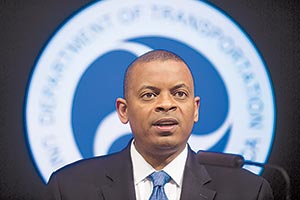Senior Reporter
Outgoing DOT Chief’s Final Report Provides Road Map for Infrastructure

This story appears in the Jan. 23 print edition of Transport Topics.
Investments in infrastructure are needed across every level of government to accommodate the massive increases in truck traffic and freight demand over three decades, outgoing Secretary of Transportation Anthony Foxx indicated in his final report as head of the agency.
Foxx called the culmination of Beyond Traffic, a 30-year outlook of the country’s transportation system that took two years to complete, one of his proudest accomplishments during his time as President Obama’s second leader of the U.S. Department of Transportation.
The final report was unveiled during the Transportation Research Board’s annual conference in Washington on Jan. 9.
“Two years ago, U.S. DOT extended an invitation to the American public to open up and have a frank discussion about the shape, size and condition of our transportation network,” Foxx wrote on the agency’s blog Jan. 17. “Beyond Traffic enabled us to see — at a high level — how our system is working, where it is deficient and what it will take to meet the needs and goals of our nation for decades to come.”
Beyond Traffic concluded that congestion inconveniences commuters, and it hinders the national economy. As the primary mode for freight, trucking will “experience significant increases” in volume over the next 30 years. And chronic congestion along truck corridors will decrease the reliability of those truck deliveries, the report said.
“Growth in overall freight demand will put increased pressure on freight bottlenecks throughout the country,” according to the report. “As our economy grows, and even by conservative estimates, it is expected to nearly double in size over the next 30 years, freight movement will increase as well, albeit at a slower rate.”
A remedy for congestion will be to improve freight planning and coordination, target policies and investments, and encourage innovative strategies to address first- and last-mile concerns, the report noted.
The secretary traveled around the country to visit with industry leaders and workers for insight into freight conditions and to see the bottlenecks that impede the flow of trucks along critical freight corridors. His travels helped shape the report’s findings.
“Beyond Traffic started a long-overdue conversation about whether our transportation infrastructure will keep pace with our changing country,” Foxx said.
Since joining the Cabinet, Foxx sought to advance the administration’s push for high-speed rail in California, promoted transportation equity initiatives, called for investments in freight and transit systems, and pushed for additional grant funding for large-scale infrastructure projects around the country.
Foxx, who succeeded Ray LaHood in 2013, is bound to be succeeded by Elaine Chao, the designee of Donald Trump. Before DOT, Foxx was the mayor of Charlotte, North Carolina.
A recent study by the American Transportation Research Institute found that congestion cost the trucking industry nearly $50 billion in 2014.

